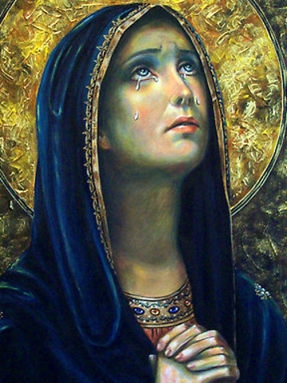Our Lady of Sorrows

"Is it nothing to you, all you who pass by me? Look and see if there is any sorrow like my sorrow."
-Lamentations 1:12; (cf. John 19:31-34)
Why the devotion to Our Lady of Sorrows?
Saint Bridget
Our Lady lamented to St. Bridget that very few consoled Her by meditating on Her Sorrows, and “that the greater part of the world lived in forgetfulness of them: ‘I look around at all who are on earth, to see if by chance there are any who pity Me, and meditate upon My Sorrows; and I find that there are very few. Therefore, My daughter, though I am forgotten by many, at least do you not forget Me; consider My anguish, and imitate, as far as you can, My grief.
For this purpose the Blessed Virgin Herself appeared in the year 1239 to the founder of the Order of the Servites, or servants of Mary, to ask them to institute a religious order in remembrance of Her sorrows.
Fatima
At Fatima, in 1916, the Angel of Peace appeared to the three child seers Lucy, Francisco and Jacinta, and after encouraging them to pray and teaching them a prayer of adoration, said “ ...The Hearts of Jesus and Mary are attentive to the voice of your supplications.” At Fatima, on June 13, 1917, Our Lady, after informing the three child seers that Jacinta and Francisco will go to Heaven soon, but that Lucy is to stay on earth some time longer, She said to Lucy, “Jesus wishes to make use of you in order to make Me known and loved”, Our Lady then said: “He wants to establish in the world devotion to My Immaculate Heart...” At Fatima, on July 13, 1917, after the child seers were terrified by the vision of hell, Our Lady said to them, “You have seen hell, where the souls of poor sinners go. To save them (poor sinners), God wills to establish in the world devotion to My Immaculate Heart. If what I say to you is done, many souls will be saved and there will be peace.
Jesus Himself further explained His will to Sister Lucy. In response to her question asking Him why He would not convert Russia without the Pope doing the Consecration of Russia, Jesus said: “Because I want My whole Church to recognize that Consecration as a Triumph of the Immaculate Heart of Mary, so that later on My Church will place devotion to My Mother’s Immaculate Heart beside devotion to My Sacred Heart.”
Other Saints and Doctors of the Church
St. Albert the Great said, “that as we are under great obligations to Jesus for His Passion endured for our love, so also are we under great obligations to Mary for the martyrdom which She voluntarily suffered for our salvation in the death of Her Son.” He said “voluntarily (suffered)", since, as St. Agnes revealed to St. Bridget, "Our compassionate and benign Mother was satisfied rather to endure any torment than that our souls should not be redeemed.”
“The grief of Mary was so great that, were it divided amongst all men, it would suffice to cause their immediate death.”
-St. Bernardine of Sienna
“While other martyrs suffered by sacrificing their own lives, the Blessed Virgin suffered by sacrificing Her Son’s life – a life that She loved far more than Her own; so that She not only suffered in Her soul all that Her Son endured in His body, but moreover the sight of Her Son’s torments brought more grief to Her heart than if She had endured them all in Her own person.”
-St. Antoninus
“The Passion of Jesus began with His birth. So also did Mary, in all things like unto Her Son, endure Her martyrdom throughout Her life.”
-St. Bernard
It was revealed to St. Bridget by an angel that, "The Blessed Virgin, even before She became His Mother, knowing how much the Incarnate Word was to suffer for the salvation of men, and compassionating this innocent Saviour, Who was to be so cruelly put to death for crimes not His own, even then began Her great martyrdom.”
“The martyrs endured their torments in their bodies; Mary suffered Hers in Her soul. Now, as the soul is more noble than the body, so much greater were Mary’s sufferings than those of all the martyrs, as Jesus Christ Himself said to St. Catherine of Siena: ‘Between the sufferings of the soul and those of the body there is no comparison.’ The Blessed Virgin Mary, for the love She bore us, was willing to see Her Son sacrificed to Divine Justice by the barbarity of men. This great torment, then, which Mary endured for us — a torment that was more than a thousand deaths — deserves both our compassion and our gratitude. If we can make no other return for so much love, at least let us give a few moments this day to consider the greatness of the sufferings by which Mary became the Queen of martyrs; for the sufferings of Her great martyrdom exceeded those of all the martyrs; being, in the first place, the longest in point of duration; and in the second place, the greatest in point of intensity. So great a love has our Heavenly Mother for us, that She deserves our gratitude, and that gratitude should be shown by at least meditating upon, and pitying Her in Her Sorrows.”
-St. Alphonsus de Liguori.
Pope Benedict XIII, in 1724, promulgated and encouraged the practice of the devotion to Our Lady’s Sorrows when he bestowed many indulgences for the recitation of the Chaplet of the Seven Sorrows. Also, Our Lady’s Sorrows are commemorated twice a year on the liturgical calendar, September 15, and the Friday before Palm Sunday. Commemorating the Sorrows of the Blessed Virgin Mary twice a year on the Roman Liturgical Calendar demonstrates how important this devotion is to Heaven.








